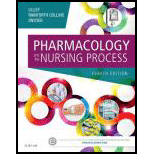
To discuss:
The normal physiology, anatomy, and related functions of the adrenal glands, including the specific hormones that are released from the glands.
Introduction:
The adrenal glands are the endocrine glands that synthesize a variety of hormones. It is located above each kidney like a cap. It is also called suprarenal glands.
Explanation of Solution
The adrenal gland is made up of two distinct parts, namely the adrenal medulla and adrenal cortex. They functionally and structurally differ from each other. The adrenal cortex is the outer layer and is made up of endocrine tissues. The adrenal medulla is the inner layer and is made up of both the endocrine and neurosecretory tissues. Each adrenal gland secretes two different hormones.
The hormones secreted by the adrenal cortex are also referred to as corticosteroids as it has the chemical structure of steroids. The corticosteroids are of two types, namely glucocorticoids and mineralocorticoids. The regulation of electrolytes in the body is carried out by the mineralocorticoids. It maintains the sodium homeostasis in the blood. It also influences the potassium and pH levels of the blood. It controls the blood pressure. The glucocorticoids affect the
The hormones secreted by the adrenal medulla are epinephrine and norepinephrine. They are referred to as catecholamines. Epinephrine is also known as adrenaline. It is an emotion causing hormone. It increases the muscle strength, heart rate, blood pressure, and sugar metabolism. Norepinephrine is also known as noradrenaline. During rest, it increases the blood pressure and heart rate of the body, increases the blood flow to the muscles, and decreases the blood flow the GI system.
The anatomy, functions, and physiology including the hormones secreted by the adrenal glands are discussed.
Want to see more full solutions like this?
Chapter 33 Solutions
Pharmacology and the Nursing Process, 8e
 Phlebotomy EssentialsNursingISBN:9781451194524Author:Ruth McCall, Cathee M. Tankersley MT(ASCP)Publisher:JONES+BARTLETT PUBLISHERS, INC.
Phlebotomy EssentialsNursingISBN:9781451194524Author:Ruth McCall, Cathee M. Tankersley MT(ASCP)Publisher:JONES+BARTLETT PUBLISHERS, INC. Gould's Pathophysiology for the Health Profession...NursingISBN:9780323414425Author:Robert J Hubert BSPublisher:Saunders
Gould's Pathophysiology for the Health Profession...NursingISBN:9780323414425Author:Robert J Hubert BSPublisher:Saunders Fundamentals Of NursingNursingISBN:9781496362179Author:Taylor, Carol (carol R.), LYNN, Pamela (pamela Barbara), Bartlett, Jennifer L.Publisher:Wolters Kluwer,
Fundamentals Of NursingNursingISBN:9781496362179Author:Taylor, Carol (carol R.), LYNN, Pamela (pamela Barbara), Bartlett, Jennifer L.Publisher:Wolters Kluwer, Fundamentals of Nursing, 9eNursingISBN:9780323327404Author:Patricia A. Potter RN MSN PhD FAAN, Anne Griffin Perry RN EdD FAAN, Patricia Stockert RN BSN MS PhD, Amy Hall RN BSN MS PhD CNEPublisher:Elsevier Science
Fundamentals of Nursing, 9eNursingISBN:9780323327404Author:Patricia A. Potter RN MSN PhD FAAN, Anne Griffin Perry RN EdD FAAN, Patricia Stockert RN BSN MS PhD, Amy Hall RN BSN MS PhD CNEPublisher:Elsevier Science Study Guide for Gould's Pathophysiology for the H...NursingISBN:9780323414142Author:Hubert BS, Robert J; VanMeter PhD, Karin C.Publisher:Saunders
Study Guide for Gould's Pathophysiology for the H...NursingISBN:9780323414142Author:Hubert BS, Robert J; VanMeter PhD, Karin C.Publisher:Saunders Issues and Ethics in the Helping Professions (Min...NursingISBN:9781337406291Author:Gerald Corey, Marianne Schneider Corey, Cindy CoreyPublisher:Cengage Learning
Issues and Ethics in the Helping Professions (Min...NursingISBN:9781337406291Author:Gerald Corey, Marianne Schneider Corey, Cindy CoreyPublisher:Cengage Learning





